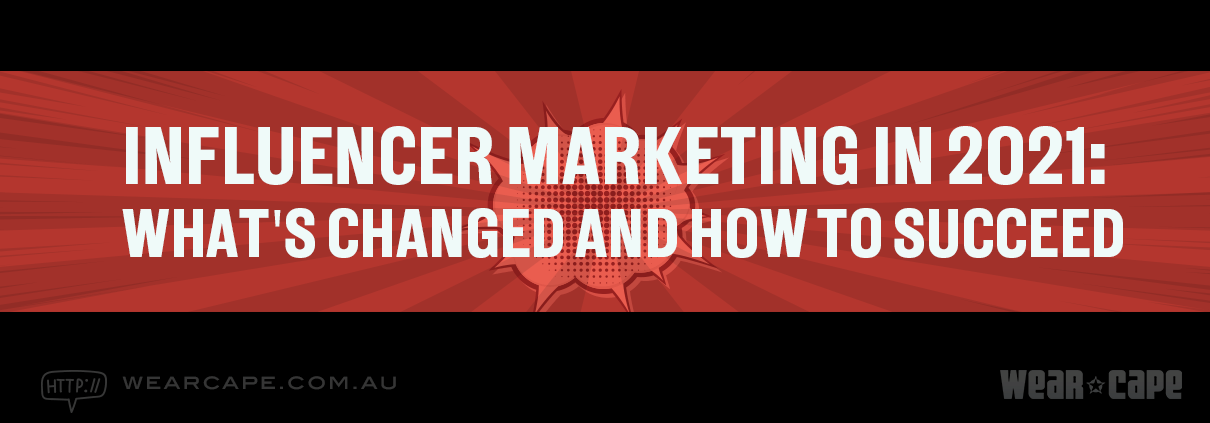Influencer Marketing in 2021: What’s Changed and How to Succeed
Influencer marketing is a constantly evolving industry, and this year has been no different.
So much of the world of business and human interaction moved online amidst the global effort to combat the COVID-19 pandemic. This provided a lot of opportunities for the influencer marketing field to grow.
As an influencer marketing agency, Wear Cape has been able to track recent evolutions in the field. In this article, we summarise exactly what’s changed for influencer marketing in 2021.
More and more people have been engaging with online content whilst spending more time at home. Influencers have seen their audiences multiply in size. Now more than ever, consumers are looking to online personalities as a source of valuable human connection.
Put simply, it’s a better time than ever to invest in the booming industry of influencer marketing.
To make the most out of influencer marketing, you need to be up on the latest trends and developments. We’re going to tell you all you need to know to succeed.
Social Influence Is Changing
We all know that the world has gone through significant change since the start of 2020. The nature of social influence is no different. It has evolved alongside people’s lives and attitudes.
Social influence is tied directly into the experiences and moods of consumers.
The content people are interested in seeing, the way people are feeling, and what they are seeking through the web are all important factors when it comes to which influencers are thriving at any given point in time. This means that they are all vital when it comes to understanding the changing landscape of social influencer marketing.
Recent world events have given much rise to a certain type of influencer: the thought leader.
As people have retreated into their homes and had less opportunity for interaction with others, these influencers have been there to provide audiences with a perfectly balanced mixture of entertainment and information. During a period in which everyone wanted to understand what was going on, these people stepped in and offered both knowledge and a moment of respite with their interesting content.
In a word, social influence has become more collectivist.
Nothing makes people pull together like being forced to spend time apart. Naturally, the hot-topic issues of 2020 and 2021 have led to a surge in advocacy – and social influencer trends reflect that.
The Rise of the Advocate
Advocates are now prominent on every platform, and their goal is to mobilise others. They inspire action of some sort with authority and expertise. Their content is often centred around people’s stories and the need for change.
When it comes to influencer marketing strategy, this rise in advocacy is very much worth noting.
The nature of these influencers does not mean they can’t sell products—far from it. In fact, they are prime for working in the industry due to the personal and intense connections they often foster with their audiences. Consider a partnership if your brand is:
- Ethical
- Sustainable
- Aligned with the influencer and their audience’s beliefs
This type of partnership may well be a fantastic decision for everyone from the brand through to the consumer. This is because people want to invest in brands that align with their social beliefs.
People all over the world are now conscious of the ethical implications of spending. Younger consumers, in particular, want to know their money is going towards companies that are environmentally friendly, socially aware, or supportive of a cause they care about. If that’s your brand, then the advocate may well want to promote you, and their audience will want to hear about you just as much.
Partnering with a social influencer who shares accurate information and is honest about their beliefs is good. It can offer you:
- Consumer trust
- A solid reputation
- High conversion
Depending on your goals, social advocates can be the best partners. They offer the ideal way to connect with younger audiences.
It’s Getting Harder to Influence Communities
Tied in with the idea of changing social attitudes, the shape of online communities has also evolved. Being online has turned into something more close-knit and personal. People have sought out others with similar interests and made closed online spaces through which they can communicate.
This sometimes makes it much more difficult to advertise effectively.
Platforms like Discord, Patreon, and Substack are becoming more and more popular. These work on a more private basis than the open platforms of Instagram and Facebook. Any brand that believes it would benefit from finding its way into their online spaces must bear some key things in mind.
If wanting to integrate into an online space, you must do so with integrity.
Compromising the sanctity of a carefully built and curated online space will do your brand no favours. If you are going to advertise to people in a closed community, make sure you genuinely believe that they will want to hear about your brand. This will encourage genuine brand-consumer relationships, rather than disturbing people during a time when society is more reliant on online spaces than ever before.
The online spaces with the highest engagement tend to be based around these things:
- A shared interest or passion
- A popular personality
- A cause that people care about
Think carefully about the audience before pursuing a partnership that will lead you into these types of spaces. Be sure to aim for brilliance rather than disaster in your choices!
Younger Audiences Like Micro-Influencers
This one is for all the brands and influencers who are looking to engage smaller audiences. Gen Z is the most likely of all age groups to follow influencers. But accounts with humongous followings have totally lost their appeal for the younger generation.
When it comes to celebrities trying to sell things outside their area of expertise, Gen Z just isn’t interested.
Instead, they prefer:
- Micro-Influencers
- Nano-Influencers
- Superfans
- People they share online spaces with
- People they share interests with
This is because these types of people offer a genuine, earnest endorsement for brands relevant to their niche. The content they enjoy is geared towards things they value, such as learning a new skill.
For brands who have something to offer to younger people, this is good news. All you need to do is find the smaller personality whose content aligns with your company. Though it sounds tricky, you can always get in touch with an influencer marketing agency for some help.
Consumers Dislike Out of Place Influencer Marketing
Over the past year, the results of key research studies have come out that will have a significant impact on marketing for influencers. Several papers have shown that consumers feel their social media experience has become oversaturated with influencer marketing posts, and they aren’t happy about it.
A further explanation comes of their responses to later questions: people are open to influencer marketing, but only that which is congruent with the influencer.
This means that audiences only want to see the people they follow advertising products and brands that make sense for their niche. Otherwise, they find the ads offputting. Though Wear Cape have worked based on this key premise for a while, the studies have shown just how important it is.
Many companies who don’t make their influencer marketing deals through an influencer marketing agency have suffered as a result.
Having no experts on hand to guide in choosing an influencer partner leads to mistakes. These can include:
- Partnering with the wrong people
- Being misled by follower counts
- Failing to set an end goal to progress towards
Ultimately, influencer marketing only has an impact on purchase intent when it is the right fit for the audience.
When it comes to choosing how, with whom, and where to undertake your campaign, you need to know whether your product or service will appear to someone’s authentic self or their ideal self. Is it a practical thing that they will research and shop around for, or is it something they want in order to feel more like an idealised version of themselves?
Figure this out, and make your influencer partner selections accordingly.
Influencer Partnerships Cannot Solve Business Scandals
The influencer marketing industry is based on the principles of integrity and trust, from both sides of a partnership. Anything that jeopardises this in the eyes of consumers is a bad thing.
A business caught up in a scandal may well be tempted to have an influencer step in and vouch for them, but 2021 audience surveys have shown that consumers see this as the manipulation tactic that it is.
When facing a crisis, using an influencer undermines the ingratiation process.
This means that all efforts to make amends and show a brand’s good intentions and past contributions to society will be for naught. Having a paid partner promote the brand during a time of scandal makes everyone involved appear insincere.
Both influencers and brands who are in the midst of a reputation crisis should step away from the influencer marketing world until their problems are solved.
This will allow them time to rebuild genuine trust and make solid, honest reparations for any wrongdoing. These parts of the crisis mitigation process cannot be overlooked.
Consumer trust is the foundation of any successful business.
Repairing it properly rather than trying to have a partner do it in one advertisement post is the right thing to do. It will be far better for limiting negative brand perceptions.
For brands that don’t work with an influencer marketing agency, these things are worth bearing in mind. If your business or your influencer partner hits a rough patch, be sure to put a pause on that campaign until it becomes clear whether it should continue in the future.
The Increase in Shoppable Media: Pros and Cons
A rise in e-commerce has been both a blessing and a curse for brands that place stock in influencer marketing. You can avoid the negatives and make use of the positives of rising e-commerce. You just need to know exactly how it’s affecting influencer marketing strategy.
More e-commerce in the influencer world means that consumers will grow accustomed to shopping as part of content.
Brands who are partnered up with influencers can also expect the shorter route from ad to purchase to increase conversion rates. This is because shoppability on social media continues to increase. It is growing easier and easier to buy online through social apps, and brands could well benefit from this.
On the flip side, it may become more and more common that influencers are marketing their own products that compete with those offered by brands.
This is why brands must be discerning going forward if trying to enter the world of influencer marketing. An influencer who is a rival seller will not offer the same seamless experience for followers when promoting your brand as opposed to their own.
There are new ways for influencers to make money. This means that brands that cannot afford to pay for sponsored content might struggle to partner with influencers.
A new way of adding value in order to compensate influencers for their work is needed. This might entail:
- Offering them free products
- Providing the use of your service without charge
- Exclusive product lines
- A cut of the proceedings.
However you choose to navigate a social media world with increased shoppability, make sure you are ready for it. Influencer marketing is set to become an even more lucrative advertising method, but only for those companies who know how to use it.
People Want Something Long Term
The latest information suggests that audiences want to see repeated engagement between influencers and brands if they are to invest. Consistency is an important part of influencer marketing strategy. It adds authenticity to the partnership between brand and influencer.
The more real an influencer marketing campaign gets, the more people will want to buy into the brand.
As the influencer makes more posts about a brand, it becomes an established part of the community that they have built with their audience. This will encourage conversion; the brand will become a familiar, trustworthy presence. This means consumers will become more and more likely to buy from it.
Longer campaigns also give time for optimisation.
Influencers make social media posts to promote partnered brands. However, there’s a chance that they won’t get maximum engagement right from the word go.
If this is the case, a longer campaign is better. It means the influencer has time to see which techniques resonate best with their audience. They can then put them to use on all future posts.
This can provide much greater yield for both parties, with ads becoming extremely effective quickly rather than running the occasional ad that suffers from the same reduced engagement.
For brands who use influencer marketing, this is good news. Once they find effective partners, they can continue working with them long term for ensured success. To foster a good, mutually beneficial working relationship, there are some things to consider:
- Compensate appropriately for high-quality content
- Use engagement as the most telling metric
- Give influencers and audiences access to exclusive products and events
- Avoid over branding, it harms authenticity
These factors can all contribute to fostering a healthy partnership that will last longer and present a deeper, more genuine bond between influencer and brand. An authentic ad will always be more effective than a one-time thing.
Brands Worry About the ROI On Influencer Marketing
Influencer marketing campaigns are being taken up by more and more companies. Still, brands are wondering if the advertising technique provides a worthwhile return on investment.
Those who work at an influencer marketing agency continue to develop more specific ways of measuring success. At the same time, they continue to set brands and influencers up in fruitful partnerships.
It’s natural for a company to carefully consider their investments. But there is a truthful answer to whether or not influencer marketing gets good results or not. It might sound oversimplified, but in this case, it’s the truth:
A brand/influencer partnership is as successful as you make it.
All of the tools that brands need to measure the ongoing success of their influencer campaigns are readily available. From metrics trackers down to the comments on the ad posts, influencer marketing is probably the easiest form of marketing to ensure success in. This is because the consumers are directly engaged with the content, and you can see whether or not they take to it immediately.
If something doesn’t take off as you’d planned, you can intervene and change upcoming ads before they go out. In this, an influencer campaign is also an incredibly flexible form of marketing.
We can’t give you a stat that has been met by every campaign. That’s because every social influencer partnership is different, and not all of them are managed well. But the experience of a company like Wear Cape suggests that a properly undertaken brand partnership is as effective as ever.
Influencer Ads Can Work Better Than TV Ads
An exciting neuroscientific study has suggested that the brain activity provoked by influencer ads is much more promising than that caused by TV ads when it comes to potential conversion. This is because it shows a much higher level of emotional response and a higher instance of memory encoding.
In the study, participants undertook standard activities like scrolling Facebook, watching TV, and looking at YouTube videos. Throughout, they were shown a series of brand adverts.
The response to TV ads was by far the weakest.
Researchers compared key measurements, which revealed that the emotional response was 277% higher for influencer ads. Memory encoding was 87% higher—this is the result that correlates with future decision making.
These results show exactly how powerful influencer marketing can be.
Similarly, the influencer ads proved more effective than corporate Facebook ads. This suggests that the successes of influencer marketing are about far more than the type of platform. It is a technique that works because people connect with people more than they connect with anything else.
Whilst a brand’s own advert might be brushed aside as nothing more than an interruption to a TV show or an irritating pause on that fascinating Facebook video, an influencer post is a direct recommendation from someone whose followers care about what they have to say.
This leads to the influencer priming effect.
Also exemplified by brain activity in the neuroscientific study, this is when a consumer becomes far more likely to respond to a less personal type of ad if they have already seen the brand on an influencer post. When people hear about something through someone they perceive as a fellow consumer, their ears perk up when more ads appear.
News like this is huge for the influencer marketing world. It serves as tangible proof of how important the human touch is when it comes to effective marketing, and just how well influencer campaigns work in providing it.
Influencer Marketing in 2021: An Industry Loaded with Potential
So, that’s influencer marketing in 2021. An up and coming industry in a phase of rapid growth that shows no signs of slowing down even in spite of pandemic impacted marketing budgets. The global market is set to be worth $13.8bn by the end of the year, and as more places decipher their own national influencer marketing worlds, the method of advertising will continue to become more effective.
It’s not something you want to miss out on, whether you’re a business or an influencer.
Soon enough, more brand/influencer partnerships than ever before will be skyrocketing towards whole new levels of mutual success. Be sure that you’re there for takeoff by getting in touch with experts at Wear Cape. It’s time to embark on an influencer marketing campaign that will bring about great things.







